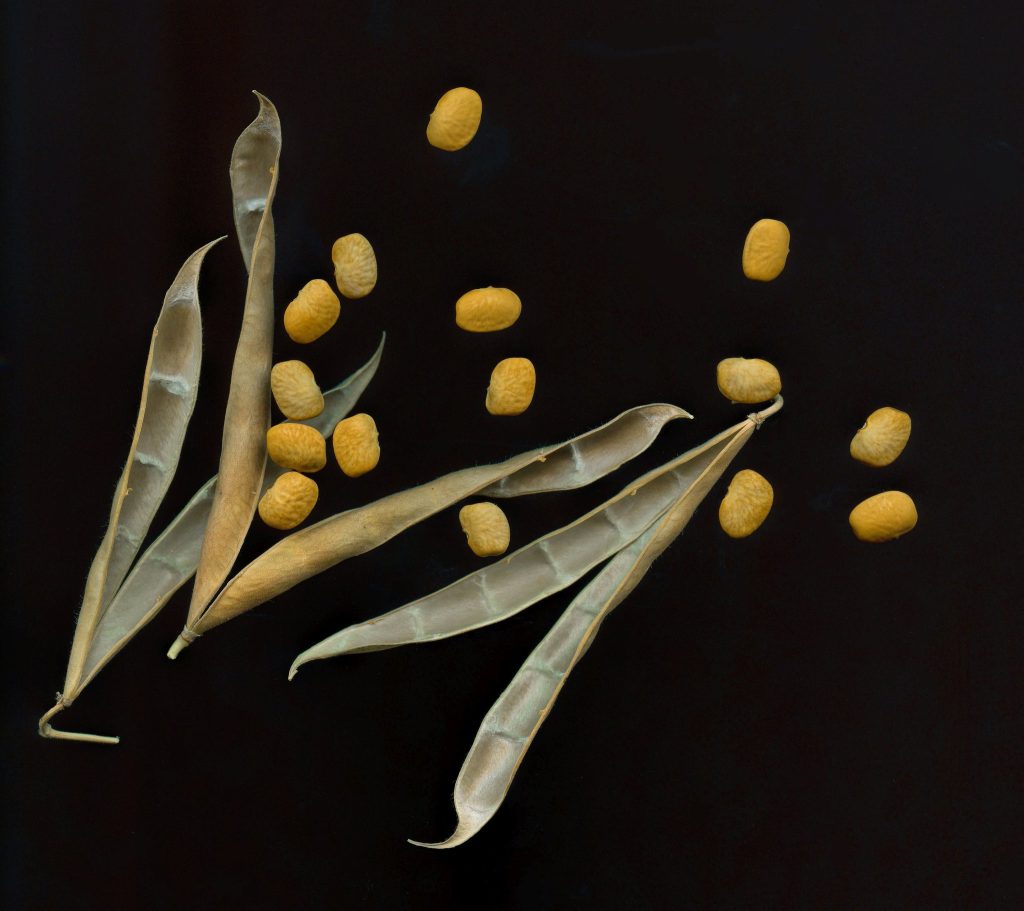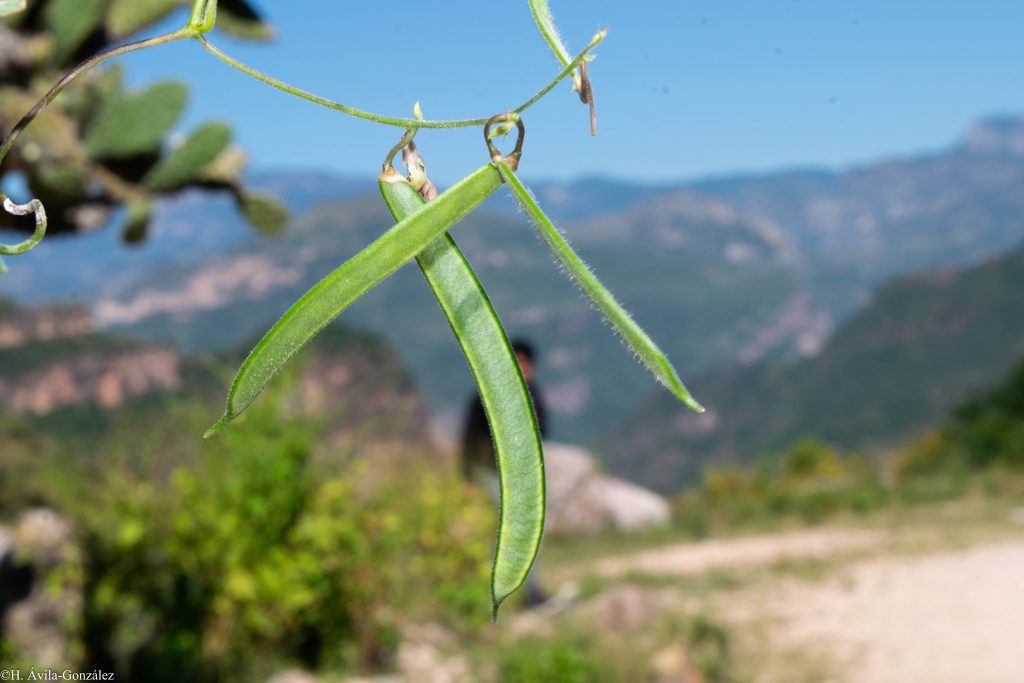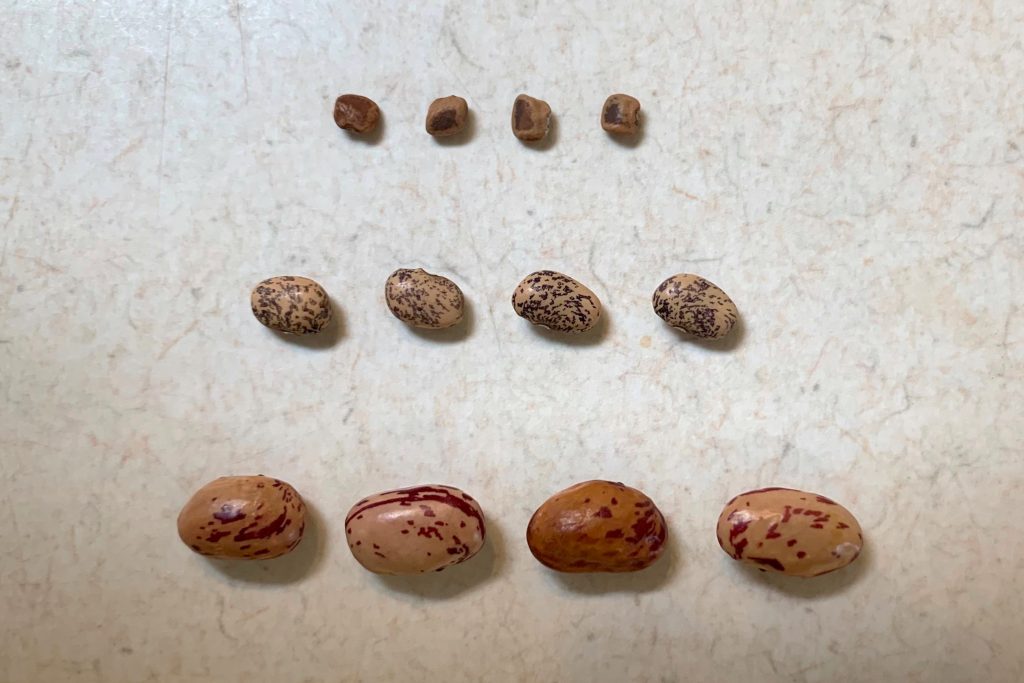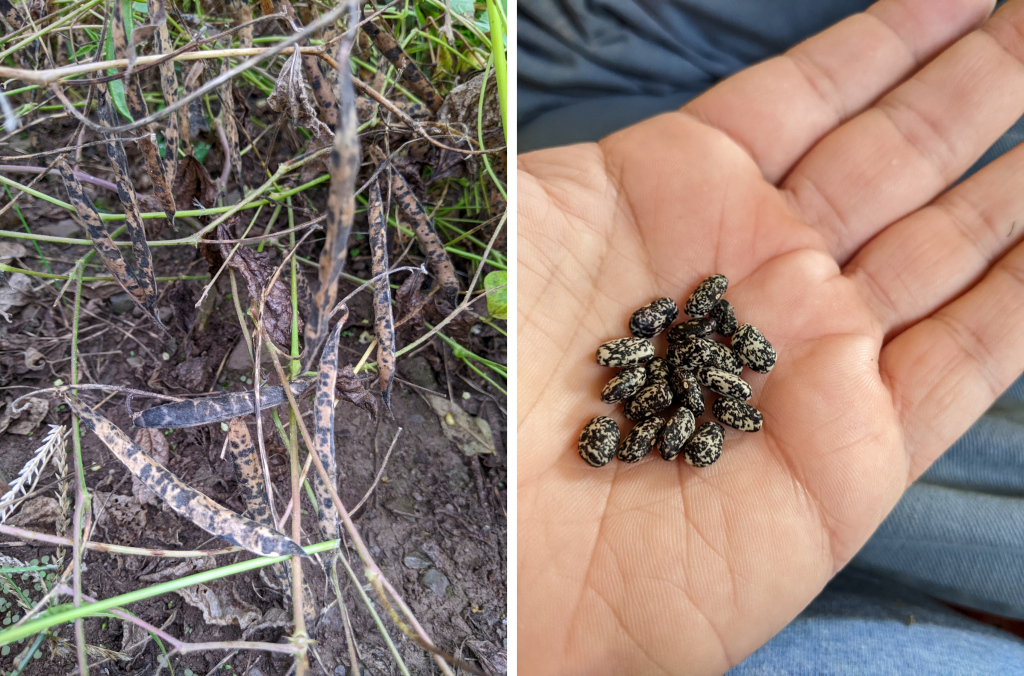Tepary Bean (Phaseolus acutifolius)
Katheryn Chen
Colorado State University, Fort Collins, Colorado 80523
Corresponding author: kat.chen@colostate.edu
OUTLINE
- Overview
- Domestication and history
- Production and use
- Research and breeding
- Expanding production range
- References
- Chapter information
1. OVERVIEW

Tepary bean (Phaseolus acutifolius A. Gray) is a pulse crop closely related to common bean (Phaseolus vulgaris L.). Like common bean, its seeds are rich in protein, fiber, and other essential nutrients. While teparies are typically cultivated for dry seed production, beans can also be processed into meal, their leaves and tender sprouts may be eaten, or they may be used as a forage or cover crop. As with other legumes, nitrogen fixing microbes colonize the roots of tepary beans, making them valuable for healthy crop rotation.
Tepary beans are native to desert and semi-arid regions of North and Central America. Just as wild tepary beans thrive in the conditions of the Sonoran Desert, their cultivated counterparts are renowned for needing very little water to grow. As climate change threatens the future of agriculture, the natural drought and heat tolerance provided by tepary bean becomes increasingly valuable to breeders and growers. In recent years, this once overlooked crop is now gaining traction both as a consumer-ready product and as a genetic resource for improving related legumes.
2. DOMESTICATION AND HISTORY

Tepary beans are native to the U.S. Southwest, Mexico, and Central America, and are best adapted to the hot, dry climate found in the western side of this range. Across this range, wild teparies were gathered for consumption, though this practice waned around the early twentieth century (Wolf, 2018). Archaeological and genetic evidence suggest that domestication began 5,000 years ago in Mexico, shaping traits such as germination time, pod dehiscence (shattering), seed size, and more (Nabhan, 1978; Garvin and Weeden, 1994). Traditionally in the Sonoran Desert, cultivated teparies were planted with corn, sorghum, and pinto beans, and irrigated with monsoon flood waters (Wolf, 2018).
Cultivated teparies have been an important subsistence crop across its native range, holding cultural significance to Tribes such as the Tohono O’odham, whose mythology speaks of white tepary beans scattered across the night sky (Wolf, 2018). The production of tepary beans saw a boom in the beginning of the twentieth century, though their popularity quickly dropped due to war, changing tastes, and the introduction of mechanized irrigation (Small, 2014; Wolf, 2018). Climate concerns and interest in expanding agricultural diversity are causing a resurgence of interest in tepary beans in recent years.
3. PRODUCTION AND USE

Tepary beans are not currently produced at the scale of common beans or other commercially successful legumes. They are generally grown on smallholder farms where they are valued as drought-tolerant cover crops, low-input forage or hay for livestock, or as a nutritious food source (Wolf, 2018). Teparies are largely grown in the drylands of the U.S. Southwest and Mexico but are also grown in more tropical climates of Mexico and Central America. Tepary landraces have been introduced to new production areas and are particularly successful in sub-Saharan Africa where other legumes struggle to withstand the harsh climate (Mwale et al., 2020).
Tepary beans can be described as hearty and sweet. They can be cooked as pot beans or used in soups, chilis, and more. When evaluating the suitability of tepary beans for some African and Middle Eastern cuisines, a taste panel judged tepary beans to be acceptable or even favorable against cowpea, chickpea, and fava beans prepared in native dishes (Tinsley et al.,1985).
Tepary bean is rich in protein and overall has a nutritional profile comparable to that of common bean (Bhardwaj and Hamama, 2004). In an evaluation of 35 different genotypes, Porch et al. (2017) found that key differences between tepary and common bean include lower fat and ash content as well as a higher sucrose concentration.
For an interesting article on the historical, culinary, and economic importance of this crop, consider reading this article from NPR.
4. RESEARCH AND BREEDING
Tolerance to abiotic stressors sets teparies apart from most other pulses, bringing much deserved attention to this underutilized crop. Yield analyses under various growing conditions indicate that teparies outperform common beans under high stress conditions (Porch et al., 2009, Porch et al., 2017). This drought and heat tolerance is related to a suite of traits including canopy biomass, pod partitioning, cellular mechanisms, and more (Rao et al., 2013; Moghaddam et al., 2021).
Many researchers consider teparies to be a potential genetic source of heat and drought tolerance for improving the economically important common bean (Barrera et al., 2022; Rao et al., 2013; Mawale et al., 2020, Porch et al., 2017; Souter et al., 2017; Moghaddam et al., 2021); however, introducing these traits through hybridization is a complex process that requires embryo rescue or the development of specific breeding lines to increase crossability (Barrera et al., 2022; Souter et al., 2017). Wild teparies have also been used to improve pest and disease resistance in common beans, including resistance to bean weevil and common bacterial blight (Kusolwa et al., 2016; Singh and Muñoz, 1999).
Genome sequence analysis of tepary and common bean germplasm confirmed the close relationship of the two species (Moghaddam et al., 2021). The tepary bean genome size was estimated at 680 Mbp with some 27,000 high-confidence genes. Based on comparative gene expression, heat tolerance of tepary bean was suggested to be due to changes in the cell cycle and synthesis of the cell protectants trehalose and antioxidant compounds (Moghaddam et al. 2021).
In addition to their utility for improving related bean species, tepary beans are themselves valuable food crops that may easily substitute more climate-sensitive beans both in the field and on the plate. Tepary breeding efforts are therefore focused on improving traits related to seed size, quality, and culinary characteristics such as cook time (Porch et al., 2024). As with all crops, ensuring resistance to multiple pests and diseases remains a breeding goal for tepary beans (Porch et al., 2013; 2024). Improving tepary bean for commercial production may be aided by trait introgression from common bean, e.g., for yield and growth habit traits (Moghaddam et al., 2021).
5. EXPANDING PRODUCTION RANGE

Since tepary beans are adapted to one of the driest parts of the country, they do not always thrive in more humid regions with lots of rainfall. Plants may fail to thrive with excessive moisture, and even plants that grow to maturity may end up with moldy seeds by harvest time.
In 2023, a limited trial was conducted to evaluate agronomically useful tepary beans that might be suitable to the Mid-Atlantic region of the United States. Genebank accession W6 38698 was selected as a promising candidate to grow at The Seed Farm at Princeton (Princeton, New Jersey) in The Experimental Farm Network’s test plot.
W6 38698 was direct seeded on June 9th. Approximately 15 plants were unirrigated, given a simple thin bamboo trellis, and left to their own devices for the season. A dry pint of beans was harvested on September 18th, almost all appearing to be in excellent condition.
This accession was able to handle everything nature threw at it during Princeton’s 2023 growing season, proving it is worth trialing in many regions beyond its native Southwest. Farmers and gardeners in the Mid-Atlantic and other regions may be able to take advantage of tepary bean’s drought tolerance, with a crop that will still ripen and produce seeds in wet years.
6. REFERENCES
Barrera S, Berny Mier y Teran JC, Lobaton JD, Escobar R, Gepts P, Beebe S, Urrea CA. 2022. Large genomic introgression blocks of Phaseolus parvifolius Freytag bean into the common bean enhance the crossability between tepary and common beans. Plant Direct 6:e470. DOI: 10.1002/pld3.470
Bhardwaj HL, Hamama AA. 2004. Protein and mineral composition of tepary bean seed. HortScience 39:1363-1365. DOI: 10.21273/HORTSCI.39.6.1363
Garvin DF, Weeden NF. 1994. Isozyme Evidence Supporting a Single Geographic Origin for Domesticated Tepary Bean. Crop Science 34:1390-1395. DOI: 10.2135/cropsci1994.0011183X003400050045x
Kusolwa, PM, Myers JR, Porch TG, Trukhina Y, González-Vélez A, Beaver JS. 2016. Registration of AO-1012-29-3-3A Red Kidney Bean Germplasm Line with Bean Weevil, BCMV, and BCMNV Resistance. Journal of Plant Registrations 10:149-153. DOI: 10.3198/jpr2015.10.0064crg
Moghaddam SM, Oladzad A, Koh C, Ramsay L, Hart JP, et al. 2021. The tepary bean genome provides insight into evolution and domestication under heat stress. Nature Communications 12:2638. DOI: 10.1038/s41467-021-22858-x
Mwale SE, Shimelis H, Mafongoya P, Mashilo J. 2020. Breeding tepary bean (Phaseolus acutifolius) for drought adaptation: A review. Plant Breeding 139:821-833. DOI: 10.1111/pbr.12806
Nabhan GP. 1978. Tepary bean domestication: Ecological and nutritional changes during P̲h̲a̲s̲e̲o̲l̲u̲s̲ a̲c̲u̲t̲i̲f̲o̲l̲i̲u̲s̲ evolution. Master’s Thesis, The University of Arizona. repository.arizona.edu/handle/10150/566678
Porch TG, Beaver JS, Brick MA. 2013. Registration of tepary germplasm with multiple‐stress tolerance, TARS‐Tep 22 and TARS‐Tep 32. Journal of Plant Registrations 7:358-364. DOI: 10.3198/jpr2012.10.0047crg
Porch TG, Cichy K, Wang W, Brick M, Beaver JS, Santana-Morant D, Grusak MA. 2017. Nutritional composition and cooking characteristics of tepary bean (Phaseolus acutifolius Gray) in comparison with common bean (Phaseolus vulgaris L.). Genetic Resources and Crop Evolution 64:935-953. DOI: 10.1007/s10722-016-0413-0
Porch TG, Ramirez VH, Santana D, Harmsen EW. 2009. Evaluation of common bean for drought tolerance in Juana Diaz, Puerto Rico. Journal of Agronomy and Crop Science 195:328-334. DOI: 10.1111/j.1439-037X.2009.00375.x
Porch TG, Rosas JC, Cichy K, Lutz GG, Rodriguez I, Colbert RW, Demosthene G, Hernández JC, Winham DM, Beaver JS. 2024. Release of tepary bean cultivar ‘USDA Fortuna’ with improved disease and insect resistance, seed size, and culinary quality. Journal of Plant Registration 18:42-51. DOI: 10.1002/plr2.20322
Rao I, Beebe S, Polania J, Ricaurte J, Cajiao C, Garcia R, Rivera M. 2013. Can tepary bean be a model for improvement of drought resistance in common bean? African Crop Science Journal 21:265-281. ajol.info/index.php/acsj/article/view/95291
Singh SP, Muñoz CG. 1999 Resistance to common bacterial blight among Phaseolus species and common bean improvement. Crop Science 39:80-89. DOI: 10.2135/cropsci1999.0011183X003900010013x
Small E. 2014. Tepary Bean – an ideal arid zone crop. Biodiversity 15: 220-228. DOI: 10.1080/14888386.2014.903203
Souter JR, Gurusamy V, Porch TG, Bett KE. 2017. Successful introgression of abiotic stress tolerance from wild tepary bean to common bean. Crop Science 57:1160-1171. DOI: 10.2135/cropsci2016.10.0851
Tinsley AM, Scheerens JC, Alegbejo JO, Adan FH, Krumhar KC, Butler LE, Kopplin MJ. 1985. Tepary beans (Phaseolus acutifolius var. latifolius): a potential food source for African and Middle Eastern cultures. Plant Foods for Human Nutrition 35:87-101. DOI: 10.1007/BF01092124
Wolf M. 2018. Plant Guide for tepary bean (Phaseolus acutifolius). USDA-Natural Resources Conservation Service, Tucson Plant Materials Center, Tucson, AZ 85705. plants.usda.gov/home/plantProfile?symbol=PHAC
7. CHAPTER INFORMATION
Chapter citation: Chen K. 2024. Tepary Bean (Phaseolus acutifolius). In: Chen K, Byrne P (Eds.) Understudied Indigenous Crops. Fort Collins, Colorado: Colorado State University. Date accessed. Available from https://colostate.pressbooks.pub/understudiedindigenouscrops/chapter/tepary-bean/
Chapter editor: Patrick Byrne
Special thanks to Nathan Kleinman (Experimental Farm Network) for contributions towards ‘Expanding production range‘.

